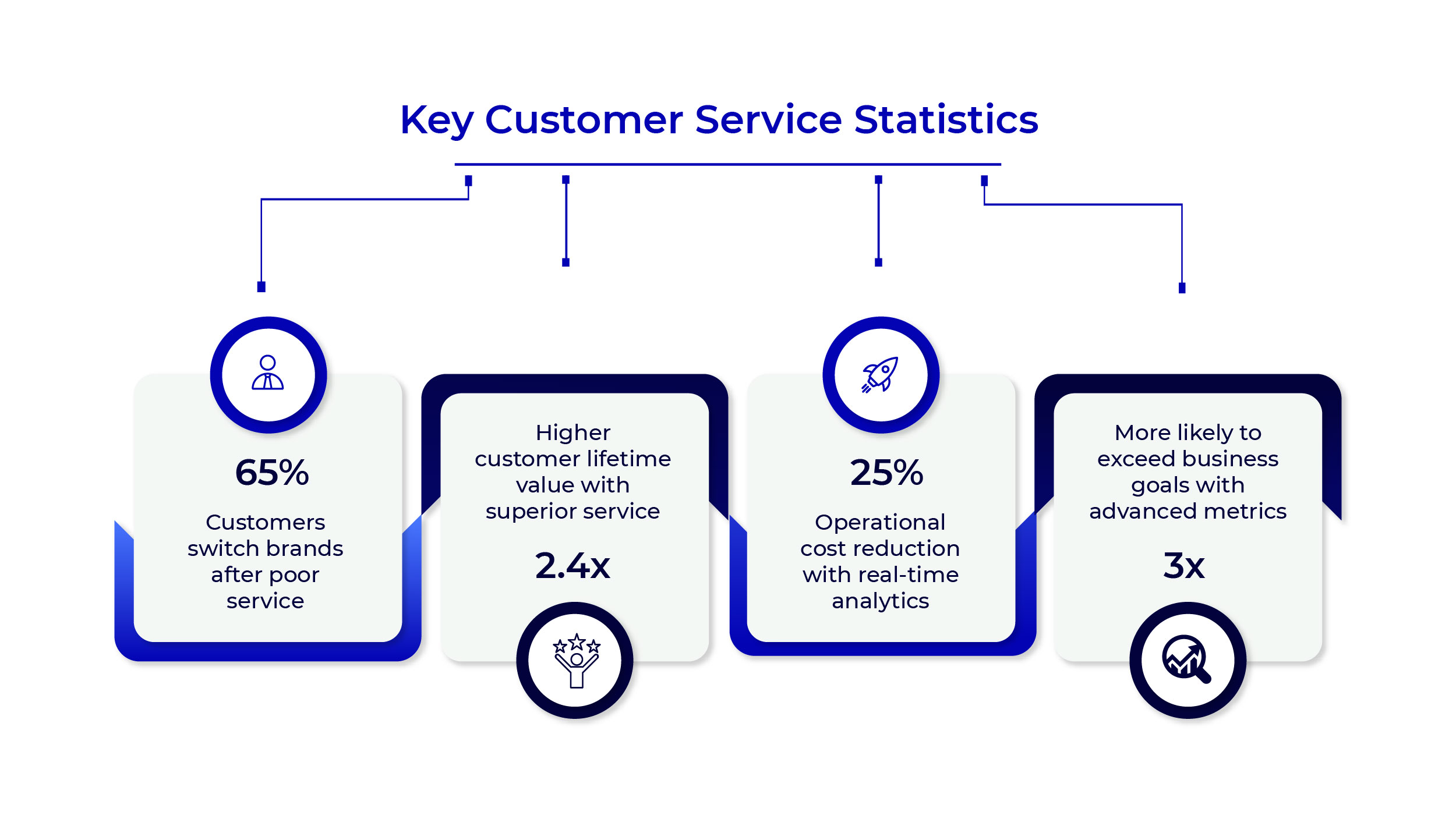In 2024, 80% of customers reported having had a negative customer service experience – yet 93% of customer service leaders acknowledged that customer expectations are higher than ever before.
This growing gap between customer expectations and service delivery isn’t just a minor issue – it’s a disconnect that impacts revenue, retention, and reputation.
So, if so many CS leaders know this problem exists, why aren’t they doing anything to mitigate their losses?
Most companies still measure customer service success using outdated metrics and fragmented data points. They make crucial business decisions based on incomplete information, leading to misaligned strategies and wasted resources.
When a single poor customer interaction can go viral and damage years of brand building, this approach is incredibly risky.
But there’s good news: advances in data analytics and AI-powered measurement tools have upgraded how businesses can track, analyze, and improve their customer service performance. Boost business growth with key efficiency metrics in customer service. Discover top customer service data metrics that enhance performance and satisfaction.
By implementing the right metrics and measurement frameworks, companies can meet rising customer expectations and turn their customer service operations into a genuine competitive advantage.
Why Traditional Approaches to Customer Satisfaction Fall Short
Remember when a simple “How did we do?” survey at the end of a call was considered adequate customer service measurement?
That doesn’t quite cut it anymore. The modern customer journey is complex and often spans a variety of channels and touchpoints – each generating valuable data that can inform service improvements and business strategy.
Most “traditional measurement” approaches face several limitations that your business can’t afford:
Single-Metric Syndrome
Relying solely on metrics like Net Promoter Score (NPS) provides an oversimplified view of customer satisfaction.
While NPS remains valuable, it fails to capture the nuanced reality of modern customer experiences. Customer service agents are essential in managing support escalations and enhancing customer satisfaction, linking their performance to overall service quality.
Delayed Insights
Monthly or quarterly reporting cycles mean businesses are often reacting to outdated information, making it impossible to address issues in real time when they matter most.
Channel Blindness
With customers moving seamlessly between chat, email, phone, and social media, siloed metrics fail to provide a complete picture of the customer journey.
Limited Business Context
Traditional metrics often fail to connect customer service performance to broader business outcomes like revenue impact, customer lifetime value, and operational efficiency.
When It Comes To Customer Service Efficiency Metrics, The Stakes Have Never Been Higher
Recent data from the 2025 ACSI Retail Study reveals the cost of these limitations: while overall retail customer satisfaction scores hover at 78.3, online retail satisfaction has actually declined by 1.2% year over year.
This decline coincides with unprecedented investment in customer service technology, suggesting that many businesses are measuring—and therefore managing—the wrong things.
Consider these compelling statistics from recent research:
- 65% of customers will switch brands after just one poor service experience
- Companies with superior customer service metrics see 2.4x higher customer lifetime value
- Real-time customer service analytics can reduce operational costs by up to 25%
- Organizations using advanced customer service data metrics are 3x more likely to exceed their business goals

The Customer Service Data Metrics You Need to Track in 2025

Organizations need a comprehensive metrics framework that captures both immediate service quality and long-term business impact. Evaluating a customer service team’s effectiveness through key performance indicators (KPIs) is one of the best ways to make sure you’re reaching the right customers – in the right ways.
Let’s look at some of the top customer service metrics to consider in 2025 and beyond:
Customer Service Data Metrics No 1. Customer Satisfaction Score (CSAT)
At its core, CSAT measures immediate customer satisfaction after specific interactions. While this state may seem straightforward, recent data shows companies using CSAT effectively see 33% higher customer retention rates.
So, how do you implement CSAT within your context?
- Keep surveys short and contextual to the interaction
- Measure CSAT across different touchpoints and channels
- Set up automated triggers for low scores to enable immediate response
- Segment CSAT data by customer type, issue category, and service channel
Customer Service Data Metrics No 2. Customer Effort Score (CES)
Your customer effort score measures how easy it is for customers to get their issues resolved – a big deal when your. trying to keep loyal customers and develop recurring revenue sources.
Most customers who are satisfied with the ease of engagement with a brand are likely to repurchase, and 81% are likely to share positive word-of-mouth. Here are some of the ways you can start tracking CES in your CX operation:
- Focus on measuring effort at key journey points
- Track CES alongside resolution time metrics
- Use customer verbatims to identify common friction points
- Implement regular journey mapping to identify high-effort touchpoints
Customer Service Data Metrics No 3. First Contact Resolution (FCR)
FCR has emerged as one of the critical customer service efficiency metrics – with studies showing that a 1% improvement in FCR can lead to a 1% improvement in customer satisfaction.
What goes into tracking an effective FCR rate?
- Define clear criteria for what constitutes “resolved”
- Track repeat contacts within a specified timeframe
- Monitor FCR variations across channels and agent groups
- Use AI tools to identify resolution patterns and opportunities
Customer Service Data Metrics No 4. Quality Assurance Score (QA)
Want to get a better idea of how customer support agents are leading to satisfied customeres? QA scores provide insight into how well agents adhere to service standards and deliver quality interactions through the top customer service requests and customer queries.
Top-performing organizations maintain average QA scores of 90% or higher. Here are some top implementation tips to consider:
- Develop clear, objective scoring criteria
- Use AI-powered tools for automated quality monitoring
- Provide regular feedback and coaching based on scores
- Track correlation between QA scores and customer satisfaction
Customer Service Data Metrics No 5. Average Handle Time (AHT)
While speed isn’t everything, AHT remains an important efficiency metric.
The key is balancing speed with quality – top performers in 2025 are reducing AHT while maintaining or improving satisfaction scores. AHT has become one of the key customer service metrics that play a role in creating long-term satisfied customers.
Here’s how you can go about implementing AHT:
- Set different AHT targets for different types of interactions
- Monitor AHT alongside resolution rates and satisfaction scores
- Use AI to identify opportunities for process improvement
- Track AHT trends to identify training needs
Customer Service Data Metrics No 6. Customer Lifetime Value (CLV)
Ask any of your customer service representatives, and they’ll likely tell you that one of their key metrics is Customer Lifetime Value. CLV connects customer service performance to long-term business value. Organizations that effectively track CLV report 60% higher profitability per customer.
Here are a few tips for implementing CLV:
- Segment CLV by customer service experience levels
- Track the impact of service interactions on future purchasing
- Monitor CLV trends across different customer segments
- Use predictive analytics to identify at-risk high-value customers
Customer Service Data Metrics No 7. Experience Quality Index (XQI)
As a newer composite metric, XQI provides a more holistic view of customer experience by combining multiple data points. When you are measuring customer service metrics, knowing you XQI cna potentially lead to a much more accurate predictions of customer behavior.
How do you start using XQI in your customer service metrics?
- Customize XQI components based on your business model
- Include both quantitative and qualitative data points
- Set up real-time XQI monitoring for key customer segments
- Use XQI trends to inform strategic decision-making
Turning Metrics into Meaningful Results
Customer service metrics in 2025 are more sophisticated than ever before – yet most businesses still aren’t using them properly. Why? Because implementing an extensive metrics framework can feel overwhelming. Customer service data metrics help simplify this process by highlighting key focus areas.
This is where partnership in the process matters. With over 15 years of experience and a track record of saving clients $50M+ through operational excellence, Atidiv specializes in turning complex customer service challenges into growth opportunities. Our data-driven approach combines:
- Real-time analytics and quality control processes that elevate efficiency
- Expert teams that seamlessly integrate with your existing operations
- 24/7 support across all channels to ensure consistent measurement and performance
- Proven frameworks that connect metrics to meaningful business outcomes
Ready to elevate your customer service metrics and transform your omnichannel customer experience? Let’s start with understanding your unique challenges and goals. Schedule a call with our team today, and discover how Atidiv can help you turn customer service data into your competitive advantage.
The future of customer service is data-driven, and the time to act is now. Partner with Atidiv to ensure your metrics aren’t just numbers on a dashboard, but catalysts for growth and customer satisfaction.
FAQs on Customer Service Efficiency Metrics
1. Why measure customer service performance using metrics?
Customer service metrics serve to help you track your growth through revenue, retention, and brand loyalty in correlation with your CX experience. These metrics reveal how well your organization meets customer expectations and delivers exceptional experiences.
2. How can a service and support team use performance metrics in customer service to improve performance?
Service and technical teams leverage metrics to establish clear benchmarks and optimize workflows. By analyzing resolution times, ticket volumes, and customer feedback, more customer support agents can identify bottlenecks, streamline processes, and focus training where it matters most.
3. What role do customer satisfaction surveys play in measuring service quality?
Satisfaction surveys capture crucial feedback about service quality and customer sentiment that raw metrics alone can’t reveal. They provide context around customer interactions and help organizations understand the complete customer journey.
4. How can businesses improve their contact resolution rate?
Contact resolution improves through a combination of agent training, streamlined processes, and smart technology implementation. Focus on equipping support agents with comprehensive knowledge bases, clear escalation procedures, and effective routing systems.
5. What metrics best indicate customer loyalty and retention?
Loyalty and retention are best measured through repeat purchase rates, churn metrics, and referral likelihood. Track customer lifetime value alongside interaction quality scores to predict long-term loyalty.
6. How can organizations handle customer inquiries more efficiently?
Efficient inquiry handling requires balancing speed with service quality through smart resource allocation and process optimization. Implement robust ticketing systems and clear service level agreements while using automation strategically.
